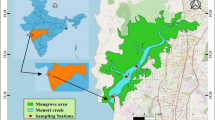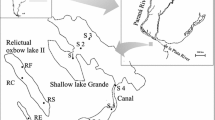Abstract
The phytoplankton of the River Lujan (Buenos Aires, Argentina) was studied for a period of 18 months, together with physical and chemical variables, in relation to a pollution gradient. 167 taxa were recorded within a seasonal succession characterized by dominance of diatoms with a brief summer green algae facies. A combination of several biotic indices and multivariate analysis was employed to assess the impact of pollution on the phytoplankton community. The biotic indices used were species diversity and richness, algal quotients (green algae/diatom ratio, Centrales/Pennales ratio) and the SD succession rate index. Multivariate procedures included cluster analysis and ordination by PCA of both species and samples, stepwise discriminant analysis and multiple discriminant analysis of variance (MANOVA). Results indicate that community dynamism is attenuated at the more polluted sites, concomitant with an increased predominance of a broad-tolerance algal assemblage, co-dominated by Cyclotella meneghiniana and Nitzschia stagnorum. The changes in the community structure and dynamics described herein involved alterations in the distribution and relative proportions of the algae, rather than modifications in the basic species composition. These changes may not be readily detectable by methods which over-simplify the ecological information, such as systems of indicator species and biotic indices, designed to assess the degree of pollution. The suitability of multivariate analysis and biotic indices in river phytoplankton studies is further discussed.
Similar content being viewed by others
References
American Public Health Association, 1975. Standard Methods for the Examination of Wastewaters, 14th edn. APHA, AWWA, WPCF, Washington, 1193 pp.
Allen, T. F. H. & J. F. Koonce, 1973. Multivariate approaches to algal stratagems and tactics in systems analysis of phytoplankton. Ecology 54: 1234–1246.
Amblard, C., 1987. Les successions phytoplanktoniques en milieu lacustre. Ann. Biol. 26: 1–34.
Austin, M. P. & P. Greig-Smith, 1968. The application of quantitative methods to vegetation survey. II. Some methodological problems of data from the rain forest. J. Ecol. 56: 827–844.
Biggs, B., 1985. Algae, a blooming nuisance in rivers. Soil Wat. 21: 27–31.
Cairns, J.Jr, G. R. Lanza & B. C. Parker, 1972. Pollution related structural and functional changes in aquatic communities with emphasis on freshwater algae and protozoa. Proc. Acad. nat. Sci. Philad. 124: 79–127.
Chessman, B. C., 1985. Phytoplankton of La Trobe River, Victoria. Aust. J. mar. Freshwat. Res. 36: 115–122.
Chessman, B. C., 1986. Diatom flora of an Australian river system: spatial patterns and environmental relationships. Freshwat. Biol. 16: 805–819.
Cotè, R., 1981. Variations saisonnières de la production primaire dans les eaux de surface de la rivière du Saguenay. Hydrobiologia 83: 3–10.
Couillard, D. & Y. Lefevre, 1985. Analysis of water quality indices. J. envir. Mgmt. 21: 161–179.
Descy, J. P., 1987. Phytoplankton composition and dynamics in the River Meuse (Belgium). Arch. Hydrobiol. 78: 225–245.
Dixon, W. J. (ed.), 1981. BMDP Statistical Software. University of California Press, Berkley.
Fischer, S. G., 1983. Succession in streams. In J. R. Barnes & G. W. Minshall (eds), Application and Testing of General Ecological Theory. Plentum Press, New York, London: 7–27.
Fjerdingstad, E., 1964. Pollution of streams estimated by benthal phytomicroorganisms. I. A saprobic system based on communities of organisms and ecological factors. Int. Revue ges. Hydrobiol. 49: 63–131.
Garcia de Emiliani, M. O., 1981. Fitoplancton de los principales cauces y tributarios del valle aluvial del rio Parana: tramo Goya-Diamante. Rev. Asoc. Cienc. Nat. Litoral 12: 112–125.
Green, R. H. & G. L. Vascotto, 1978. A method for the analysis of environmental factors controlling patterns of species composition in aquatic communities. Wat. Res. 12: 583–590.
Guhl, W., 1987. Aquatic ecosystem characterized by biotic indices. Int. Revue ges. Hydrobiol. 72: 431–455.
Hammer, U. T., 1983. Limnological studies of the lakes and streams of the upper Qu'Appelle River System, Saskatchewan, Canada. Hydrobiologia 99: 125–144.
Kiss, K. T., 1984. Changes in trophity conditions in the River Danube at God. Annal. Univ. Sci. Budapest, Sect. Biol. 24–26: 47–59.
Kiss-Keve, I., 1974. Effect of the turbidity of the water on the development of algal associations in the Tisza. Tiscia/Szeged. 9: 9–24.
Kolkwitz, R. & M. Marsson, 1908. Okologie des pflanzenlichen Saprobien. Ber. Deutsch. Bot. Ges. 26: 505–519.
Lebart, L., A. Morineau & J. P. Fenelon, 1979. Traitement des Donnés Statistiques. Ed. Bordes, Paris, 510 pp.
Lakshminarayana, J. S. S., 1965. Studies on the phytoplankton of the River Ganges, Varanasi, India. Hydrobiologia 25: 119–165.
Leclercq, L., 1984. Etude écologique des rivières du nord du massif Ardennais (Belgique): flore et végétation de diatomées et physico-chimie des eaux. 2. Typologie des milieux naturels. Robertville, Stat. scient. Hautes-Fagnes, 5 + 329 pp.
Lewis, W. M., 1978. Analysis of succession in a tropical phytoplankton community and a new measure of succession rate. Am. Nat. 112: 401–414.
Margalef, R., 1969. El concepto de polución en limnologia y sus indicadores biológicos. Agua 7: 103–133.
Margalef, R., 1983. Limnologia. (ed.) Omega, Barcelona, 1010 pp.
Nalewajko, C. & D. R. S. Lean, 1980. Phosphorous. In I. Morris (ed.), The Physiological Ecology of Phytoplankton. Blackwell Scientific Publications, Oxford: 235–258.
Nygaard, G., 1949. Hydrobiological studies in some ponds and lakes. Part II. The quotient hypothesis and some new or little known phytoplankton organisms. Kgl. Danske. Vidensk. Selsk. Biol. Skrifter 7(1): 1–293.
Odum, E. P., 1971. Fundamentals of Ecology, 3d edn. W.B. Saunders Co, Philadelphia, London, Toronto, 574 pp.
Orlocci, L., 1966. Geometric models in ecology. I. The theory and application of some ordination methods. J. Ecol. 54: 193–215.
Pielou, E. C., 1984. The Interpretation of Ecological Data. John Wiley & Sons, New York, 263 pp.
Rai, H., 1974. Limnological studies of the River Yamuna at Delhi, India. Part II. Arch. Hydrobiol. 73: 492–517.
Reynolds, C. S., 1984. The Ecology of Freshwater Phytoplankton. Cambridge University Press, Cambridge, 384 pp.
Rawson, D. S., 1956. Algal indicators of trophic lake types. Limnol. Oceanogr. 1: 18–25.
Sabater, S. & F. Sabater, 1988. Diatom assemblages in the River Ter. Arch. Hydrobiol. 111: 397–408.
Shannon, C. E. & W. Weaver, 1949. A Mathematical Theory of Communication. Univ. Illinois Press, Urbana, Chicago, London, 125 pp.
Simm, A. T., 1985. The phytoseston of the Vistula River between Góra Kalwaria and Nowy Divór Mazowiecki in 1982. Ekol. Pol. 33: 439–453.
Slàdeček, V., 1973. System of water quality from the biological point of view. Ergeb. Limnol. 7: 1–218.
Smayda, T., 1980. Phytoplankton species succession. In I. Morris (ed.), The Physiological Ecology of Phytoplankton. Blackwell Scientific Publications, Oxford: 493–570.
Sournia, A. (ed.), 1978. Phytoplankton Manual. Monographs of oceanographic methodology, UNESCO, 337 pp.
Swale, E. M. F., 1969. Phytoplankton in two english rivers. J. Ecol. 57: 1–23.
Talling, J. F., 1976. Phytoplankton: composition, development and productivity. In J. Rzoska (ed.), The Nile: Biology of an Ancient River. Den Haag: Dr W. Junk: 385–406.
Utermöhl, H., 1958. Zur Vervollkommnong der quantitativen Phytoplankton metodik. Mitt. int. Ver. Limnol. 9: 1–38.
Weber, C. I. & D. Moore, 1967. Phytoplankton, seston and dissolved organic carbon in the Little Miami River, Ohio. Limnol. Oceanogr. 12: 311–318.
Wetzel, R. G., 1975. Limnology. W.B. Saunders Co, Philadelphia, London, Toronto, 743 pp.
Willen, E. & T. Willen, 1979. Phytoplankton in freshwater monitoring. The National Swedish Environmental Protection Board, Report PM 1151: 184–195.
Williams, L. G., 1964. Possible relationships between plankton-diatom species numbers and water-quality estimates. Ecology 45: 809–823.
Wolf, H., 1982. Method of coding ecological data from diatoms for computer utilization. Mededel. Rijksgeol. Dienst. 36 (2): 95–110.
Wu, J. T., 1986. Relation of change in river diatom assemblages to water pollution. Bot. Bull. Academia Sinica 27: 237–245.
Author information
Authors and Affiliations
Rights and permissions
About this article
Cite this article
del Giorgio, P.A., Vinocur, A.L., Lombardo, R.J. et al. Progressive changes in the structure and dynamics of the phytoplankton community along a pollution gradient in a lowland river — a multivariate approach. Hydrobiologia 224, 129–154 (1991). https://doi.org/10.1007/BF00008464
Received:
Accepted:
Issue Date:
DOI: https://doi.org/10.1007/BF00008464




